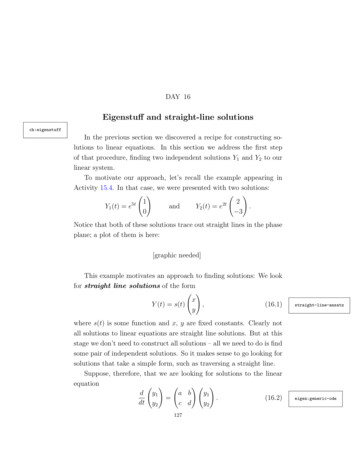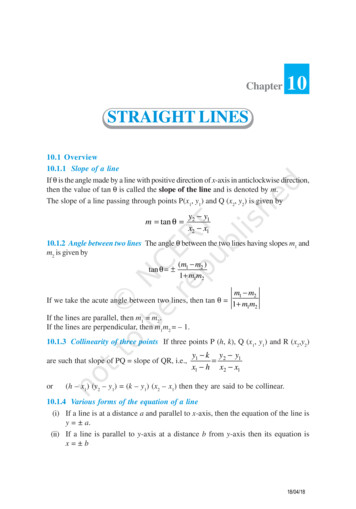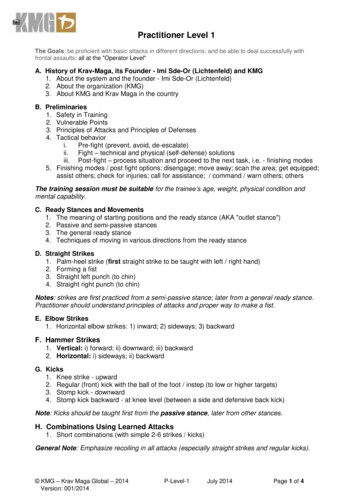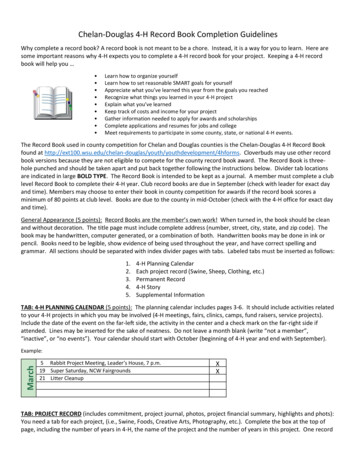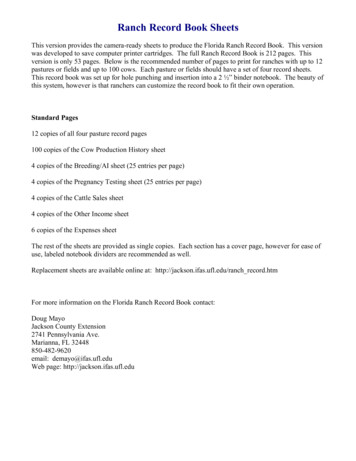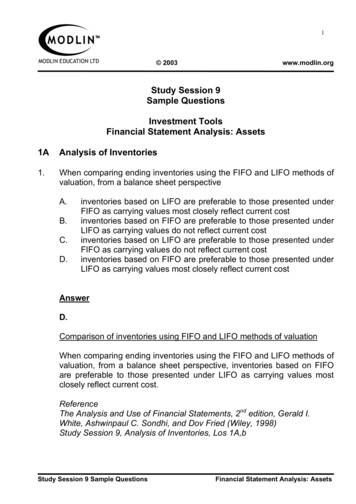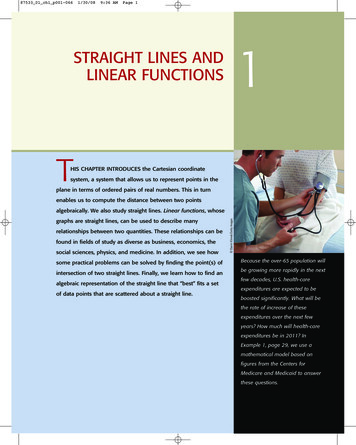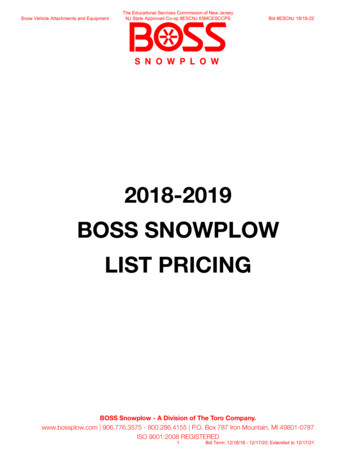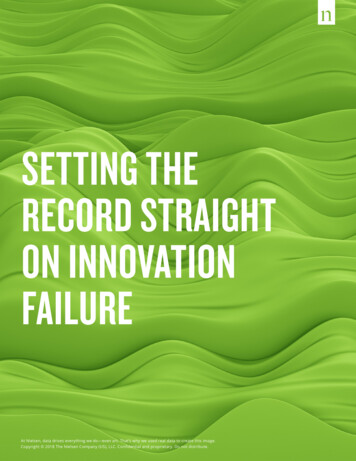
Transcription
SETTING THERECORD STRAIGHTON INNOVATIONFAILUREAt Nielsen, data drives everything we do—even art. That’s why we used real data to create this image.Copyright 2018 The Nielsen Company (US), LLC. Confidential and proprietary. Do not distribute.1
ARE SMALL BRANDS REALLYBETTER AT INNOVATION?Ramon Melgarejo,Senior Vice President,Product Leadership atNielsen BASESThe failure rate of new products has always been high. However, in recentyears, a number of nimble upstarts have emerged as fierce competitorsto well-established category leaders. Their success has driven many largemanufacturers to question whether their resources, scale, and processesare weaknesses that should be discarded in favor of a new “agile” playbook emulating these emerging competitors (or the tech titans of SiliconValley). In doing so, it is easy to forget that the most prominent newplayers represent a very small sample, and there are many others whofailed to gain traction along the way.Kamal Malek, Ph.D.,Senior Vice President,Data Science atNielsen BASESFOR EVERY DOLLAR SHAVE CLUB, THEREARE MORE THAN A FEW 800RAZORS.In a recent paper, the Ehrenberg-Bass Institute for Marketing Sciencepointed out that, for every Dollar Shave Club, there are more than afew 800Razors. In fact, because so many startups never achieve a sizelarge enough to be tracked, capturing the failure rate is impossible. Inshort, innovators tend toward “survivor bias”—a phrase coined by theEhrenberg-Bass Institute:“Small brands are able to post higher percentage growth than large brandsbecause any growth is from a low sales base. But they are also more likely tofall completely out of the market than big brands. ‘Survivor bias’ can causeanother error in analysing growth: it’s only the shares of surviving small brandsthat are tracked so the average performance of small brands is inflated.”1Copyright 2018 The Nielsen Company (US), LLC. Confidential and proprietary. Do not distribute.2
Nevertheless, the belief enduresthat these small players are doingsomething right, and this “something”is a function of being small. Is it bettertargeting through digital media?Streamlined pre-market testingprotocols? The ability to test and learnin-market because they rely less ontraditional retailers? Setting asidethe matter of whether these tacticsare actually deliberate choices or theQUESTIONS LIKE “WHATMADE HALO TOP ICE CREAMSO SUCCESSFUL?” AND“HOW DO WE CONSISTENTLYLAUNCH MORE SUCCESSFULINNOVATIONS?” DON’TNECESSARILY HAVE THESAME ANSWER.only available choice due to limited resources, large manufacturers havestarted to adopt these methods in pursuit of a new formula for success.However, we must realize that questions like “What made Halo Topice cream so successful?” and “How do we consistently launch moresuccessful innovations?” don’t necessarily have the same answer. In fact,a replicable formula for innovation success is more likely to come fromscrutinizing the patterns revealed by postmortem analyses of failedlaunches—approximately 80-85% of all fast-moving-consumer-good(FMCG) launches—than from rare case studies of category disruptors.Looking across thousands of product launches, we’ve observed threecommon causes of innovation failure that often don’t get the attentionthey deserve:1.Neglecting to address a broad consumer need2.Failing to provide a good product experience3.Providing insufficient marketing supportCopyright 2018 The Nielsen Company (US), LLC. Confidential and proprietary. Do not distribute.3
THREE COMMON CAUSESOF INNOVATION FAILURE#1 - NEGLECTING TO ADDRESS A BROAD CONSUMER NEEDApproximately one half of initiatives tested don’t effectively articulate toconsumers how they deliver on a broad consumer need. In some cases,such as when the proposition is premium or targeted to a very specificaudience, this is by design. Still, for a “niche” brand to have a chance ofsuccess, it must be incremental to the brand or to the category—ideallyboth. However, our preliminary R&D reveals that only 5% of conceptsthat lack broad appeal will deliver above-average incrementality to thebrand. In other words, launches considered niche are rarely incrementaland could actually shrink the brand depending on how much support ismisdirected to them. These findings corroborate the empirical analysisconducted by the Ehrenberg-Bass Institute for Marketing Science whichsuggest that, while successful niche launches are possible, they areONLY 5% OFCONCEPTSTHAT LACKBROAD APPEALWILL DELIVERABOVE-AVERAGEINCREMENTALITY.extremely rare. Therefore, while the use of newer technologies that allowfor more targeted communications and new distribution strategies (e.g.,e-commerce launches, regional launches, etc.) can provide a boost fortargeted products, the safest and most realistic path to innovation successis to develop a product with broad appeal.BREAKDOWN OF EVALUATED INNOVATIONSCopyright 2018 The Nielsen Company (US), LLC. Confidential and proprietary. Do not distribute.4
THE HIDDEN COST OF VALIDATING ACONSUMER NEED POST-LAUNCHA common chapter in the “agile play-book”adopted by many large FMCG brandsfocuses oniteration.TheThein-markethidden costof validatingaprocess consumergoes like this:havingidentified aneedpost-launchpotentially promising need state to target,#2 - FAILING TO PROVIDE A GOOD PRODUCT EXPERIENCEManufacturers striving to bemore agile are streamlining theirproduct testing prior to launch,increasing the likelihood thatconsumers’ first experience withtheir products will be suboptimal.47% OF INNOVATIONPROFESSIONALS CONFESSEDTHAT PRODUCT TESTING TENDSTO SUFFER MOST WHEN SPEEDTO MARKET IS A PRIORITY.In a recent survey of more thana product is placed in an e-commerce350 innovation professionals, 47% confessed that testing and refining theenvironment.Throughrapid A/BtestingA commonchapterin the“agileor opted by manyinnovation process when speed to market is a priority.3gathers insightsto validatetheconsumerlarge FMCGbrandsfocusesonneed andprovide directionon Thehowprocessthein-marketiteration.product goescan beimproved.The factthatlikethis: havingidentifiedthese incubatedlaunchesare of smallera potentiallypromisingneedscope and seem to have no opportunitycosts suggests that there are no financialconsequences to failing fast and learning.product experience tends to suffer most compared to other stages of theIn addition to ensuring a good initial usage experience, productexperience is a key driver of long-term success. Brands often overestimatethe loyalty of repeat buyers. On average, it takes approximately sevenrepeat purchases for a consumer to become a truly loyal buyer.4Between the trial purchase and the first repeat purchase, a brand willlose approximately half of its buyers. From the first repeat purchase tothe second, the brand will again lose half of the remaining buyers. ThisThis couldn’t be further from the truth.cycle continues until it stabilizes—around the eighth purchase. Without aIn a world of shrinking research budgetsstrong product experience, brands won’t make it to that eighth purchase,and timelines, the effort required toespecially given the proliferation of new entrants, promotions, andproperly launch, track, iterate, and repeatunavoidable variety-seeking.a series of conclusive in-market testscertainly isn’t trivial. Ironically, if thereare advantages that smaller brands haveBUYER ATTRITIONover entrenched competitors, it would bemore time and focus, not less. This isn’t tosay that small players don’t feel pressureto launch to market quickly—they do.However, they don’t have to contend with“sibling brands” competing for resourcesfrom the parent company or pressurefrom financial markets to show moreimmediate returns. Said another way, asmaller brand does not have to wrestlewith the question, “Should we invest in theinnovation, or should we put this moneybehind our established brand?” The onlyoption is to innovate. In the case of largebrands, there certainly is an opportunitycost worth considering: allocatingresources to a losing launch that could’vemade a big impact elsewhere.Copyright 2018 The Nielsen Company (US), LLC. Confidential and proprietary. Do not distribute.5
With the world’s largest product testing database, BASES has observedthat initiatives with strong product performance are 15 times more likelyto succeed in market than those with poor performance. Moreover, thosethat BASES deems “not ready” on product-driven dimensions but launchanyway have an 80% failure rate in-market. The difference between astrong and a weak product experience can result in sales difference of30% in year one. Closing this gap through fast, efficient pre-market testing80%FAILURE RATE FOR LAUNCHES DEEMED “NOTREADY” IN PRE-MARKET PRODUCT TESTS BUTLAUNCH ANYWAYhas considerable advantages over experimenting in-market.5RETAIL SALES MAPPED TO PRE-MARKET TEST PERFORMANCE30%RETAIL SALES IN MILLIONSGREATER YEAR-ONE SALES FOR LAUNCHESWITH STRONG PRODUCT PERFORMANCE OVERTHOSE WITH WEAK PERFORMANCEPRODUCT PERFORMANCEAssumes a typical food product category, 1SKU, 3.30 retail price, 68% year-end distribution, 7M advertising spend,average trade/consumer promotion, and no competitive order of entry effects. Database rank assumes purchaseintent, value, claimed units, and claimed frequency all fall into these respective quintiles. “Average” performanceequates to a database ranking in the 50th percentile.Why products should be thoroughly tested prior to launchFollowing Silicon Valley’s lead, some innovators believe that optimizing theproduct post-launch—introducing a small batch, monitoring the results,revising the product, re-launching, and repeating the cycle—is the bestmethod. In practice, we’ve found that software development strategiesare not so seamlessly applied to physical consumer products. Whereasconsumer expect software to have bugs that will be corrected withindays of being identified, they don’t expect FMCG brands to release foodor personal care products with updated formulations weeks or monthslater. When the initial product experience doesn’t win over consumers,they are highly unlikely to purchase that product a second time. Moreover,altering the initial formulation of a product can cause backlash from thoseconsumers who preferred the original version.Copyright 2018 The Nielsen Company (US), LLC. Confidential and proprietary. Do not distribute.6
Practically speaking, the user experience of FMCG products can’t bemeticulously tracked and improved with a simple app update. Moreover,in-market product tests are time-consuming and expensive; consumerfeedback can be difficult to dissect; there is risk of exposing the innovationto competitors; and there is always a risk that poor product reviews willendure on social media in perpetuity, ultimately harming trial rates downthe line.Interestingly, a recent analysis of budgeting in the FMCG and technologysectors revealed that technology companies tend to dedicate significantlymore of their budgets to R&D and significantly less to marketing, comparedwith their FMCG counterparts.6 If anything, FMCG brands should spendmore time developing and refining their value proposition.Taking a step back, we should ask ourselves why some brands believe thatpost-launch product tests are inherently better. While these tests providea real-life environment, tried-and-true predictive methods exist that don’trequire unnecessary risk, complexity or expense.R&D VS. MARKETING INVESTMENTFMCGCopyright 2018 The Nielsen Company (US), LLC. Confidential and proprietary. Do not distribute.TECH7
#3 - PROVIDING INSUFFICIENT MARKETING SUPPORTA review of 600 product launches across multiple markets and categoriesrevealed that one-third of the initiatives failed as a function of insufficientmarketing support.7 Interestingly, an exceedingly strong product orYEAR TWO MEDIA SPEND AS APERCENTAGE OF YEAR ONEproposition would’ve made little difference for these launches—they simplydidn’t have the baseline marketing support needed to get the ball rolling.Unfortunately, marketing support challenges tend to stretch beyondyear one. To remain competitive in year two, products can’t rely only onrepeat customers—they also need a healthy influx of new triers. Becausesustained trial demands a continued and growing awareness of theproduct, an investment in media is typically required to keep the productfresh in consumers’ minds. Despite this reality, budgets are often cut afteryear one, which erodes sales velocities. Eventually, this results in a lossof distribution and inevitable decline in years two and three. This chainreaction explains why two-thirds of new products decrease in volumeduring their second year in market.Overly-optimistic planning is a common culpritThough these problems become apparent after one or more years inmarket, they begin much earlier in the innovation planning stage. Basedon a recent analysis of 80 randomly-selected U.S. product launches acrossmultiple categories, most of the variance between the initial forecastedsales estimates and the actual in-market performance could be explainedby overly-optimistic marketing assumptions. The average volumetricdifference between these two scenarios—planned vs. actual support—wasapproximately 30%.8THERE’S A CONSISTENT BIAS TOWARDSIGNIFICANTLY OVERSTATING THEANTICIPATED LEVEL OF MARKETING SUPPORT.Regardless of client, country and category, many similar analyses we’veconducted over the years tell the same story: there’s a consistent biastowards significantly overstating the anticipated level of marketing support.Copyright 2018 The Nielsen Company (US), LLC. Confidential and proprietary. Do not distribute.8
One could argue that it’s impossible to predict accurately what will happenwhen the product finally launches; innovation cycles can take months oreven years, during which time both internal budgets and the marketplacecan shift considerably.BASES FORECASTING TEAMS HAVE PARTNEREDWITH SELECT CLIENTS TO REDUCE THEVARIANCE CREATED BY FAULTY ASSUMPTIONSFROM 30% TO 5%.Over the past few years, BASES forecasting teams have partnered withselect clients to improve the accuracy of marketing assumptions, reducingthe variance created by faulty assumptions from 30% to 5%.9 As objectivearbiters free from internal politics and priorities, the BASES forecastingteams leverage category benchmarks, past execution history, andknown best practices to make considerably more accurate predictions ofexpected levels of support. Though it requires effort, skill and access tothe right information, we know that predicting accurate marketing inputsin advance can be done.PLANNED VS. ACTUALSPEND DIFFERENCEMARKETING PLAN ANALYSIS(EXPECTED VS. ACTUAL SUPPORT)75% of marketing plans overstateor understate marketing supportby at least 10%.NUMBER OF MARKETING PLANS EVALUATEDCopyright 2018 The Nielsen Company (US), LLC. Confidential and proprietary. Do not distribute.9
CONCLUSIONWhile many of the positions stated here are not necessarily popular,there is robust data to support them. New methods, interfaces andframeworks can be valuable, but they’re no substitute for addressing morefundamental challenges that continue to plague many manufacturers.The principles driving innovation success remain relatively simple on thesurface: Invest in a good idea Transform it into a fantastic product that delivers on the promise Effectively support the brand in year one so it has a chance tocompete Have the patience to drive enough penetration to build sustainablevolume Maintain organizational focus on only those innovations that will driveoverall brand growthThe easiest path to the first page of search results, positive social mediamentions, and a five-star rating is to offer a fantastic product experienceNEW METHODS,INTERFACES ANDFRAMEWORKS ARENO SUBSTITUTE FORADDRESSING MOREFUNDAMENTALCHALLENGESTHAT CONTINUETO PLAGUE MANYMANUFACTURERS.that delights consumers.SOURCES1Ehrenberg-Bass Institute for Marketing Science, “Are Big Brands Dying?” October 20172Ongoing BASES R&D analysis3BASES client survey, May 20174BASES R&D analysis5BASES R&D analysis6CircleUp, “The Product Launch Fallacy of Big CPGs,” March 2017.7BASES R&D analysis, 2017.8BASES R&D analysis, 2017.9BASES R&D analysis, 2017.Copyright 2018 The Nielsen Company (US), LLC. Confidential and proprietary. Do not distribute.10
ABOUT NIELSENNielsen Holdings plc (NYSE: NLSN) is a global measurement and data analytics company thatprovides the most complete and trusted view available of consumers and markets worldwide. Ourapproach marries proprietary Nielsen data with other data sources to help clients around the worldunderstand what’s happening now, what’s happening next, and how to best act on this knowledge.For more than 90 years Nielsen has provided data and analytics based on scientific rigor andinnovation, continually developing new ways to answer the most important questions facing themedia, advertising, retail and fast-moving consumer goods industries. An S&P 500 company, Nielsenhas operations in over 100 countries, covering more than 90% of the world’s population. For moreinformation, visit www.nielsen.com.Copyright 2018 The Nielsen Company (US), LLC. Confidential and proprietary. Do not distribute.11
book emulating these emerging competitors (or the tech titans of Silicon Valley). In doing so, it is easy to forget that the most prominent new players represent a very small sample, and there are many others who failed to gain traction along the way. In a recent paper, the Ehrenb



